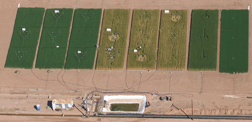Examining Climate Change Effects on Wheat
Increasing temperatures can drastically reduce crop yields, make irrigation a necessity, and increase the threat of drought. So for wheat growers in the southwestern United States and elsewhere, climate change is a major concern. Agricultural Research Service researchers at the U.S. Arid-Land Agricultural Research Center in Maricopa, Arizona, have been helping growers prepare for the changing times by turning up the heat in experimental wheat fields to levels anticipated by 2050.
“No one knows exactly how changing conditions will affect yields in the decades ahead, and we’re trying to give growers an idea about what they might expect, and how they can address warming issues and minimize losses,” says Bruce Kimball, a retired ARS soil scientist who was the project leader.
In Arizona, wheat is normally planted in midwinter. It is harvested in late May and irrigated throughout its growing season. Temperatures can range from below freezing in winter to above 100˚F in May.
Kimball, ARS plant physiologists Gerard Wall and Jeffrey White, and agronomist Michael Ottman of the University of Arizona planted wheat every 6 weeks in separate plots between March of 2007 and May of 2009. They applied heat to 6 of the 15 plantings, warming the crops that were planted in March, September, and December. They measured canopy conditions to make sure temperatures in the heated plots rose by 2.7˚F in the daytime and by 5˚F to 6˚F at night. They call the effort the “Hot Serial Cereal” project because they grew wheat, a cereal crop, in a series of plantings and heated the plants as they grew.
To warm the plots, the researchers used six 1,000-watt infrared heaters suspended above the plants in a hexagonal pattern, forming a temperature free-air controlled enhancement (T-FACE) apparatus. Developed by Kimball, T-FACE enables scientists to raise the temperature of experimental crops in open fields. The technology is also being used by ARS researchers on grazinglands in Wyoming and soybean fields in Illinois and by more than a dozen other research groups around the world.
The researchers measured growth, yield, and several other soil and plant physiological variables. As expected, the heaters accelerated growth, increased soil temperatures, reduced soil moisture, induced mild water stress on the crops, and had a nominal effect on photosynthesis. But effects on yields depended on when the wheat was planted. When heat was applied to wheat planted normally, in midwinter, its growth cycle was ahead by a week. There were no major differences in yield. Adding heat to wheat planted in March reduced yields by half. Most surprising, rather than reducing yields, adding heat to wheat planted in September protected the plants from damaging frosts between Christmas and New Year’s both years. Heated plots showed only moderate yield loss, whereas the wheat in the unheated control plots yielded nothing.
The results may provide guidance for adjusting planting schedules as the climate warms. The researchers are developing computer models that could be applied to any region, making the results useful for adapting planting schedules to changing climates worldwide.
This research supports the USDA priority of responding to climate change.—By Dennis O'Brien, Agricultural Research Service Information Staff.
This research is part of Global Change, an ARS national program (#204) described at www.nps.ars.usda.gov.
To reach scientists mentioned in this article, contact Dennis O’Brien, USDA-ARS Information Staff, 5601 Sunnyside Ave., Beltsville, MD 20705-5129; (301) 504-1624.
"Examining Climate Change Effects on Wheat" was published in the February 2011 issue of Agricultural Research magazine.







